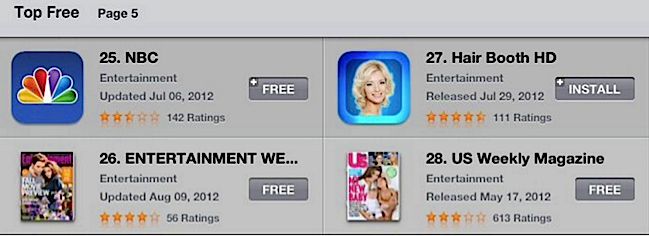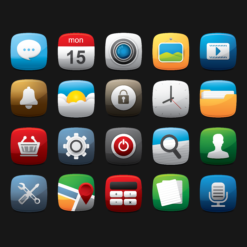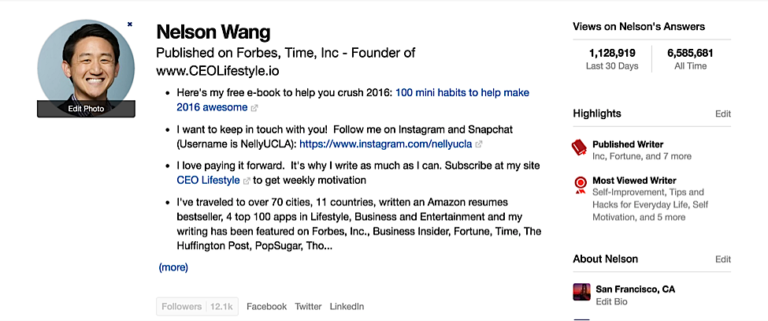This post originally appeared on Growth Everywhere, a marketing and business growth blog.
I shut down my startup this year.
It really sucked.
I had poured a lot of sweat and tears into my app company, but it didn’t matter. It wasn’t meant to be.
But just because it didn’t work out for me, doesn’t mean it can’t work out for you. In fact, it made me more motivated than ever to write this blog post because I’d like to share the lessons I learned along the way. I wish I had gotten this insight early on when I first started out—it would have saved me a ton of heartache.
Over the last 5 years, I’ve started two companies, built fourteen iPhone apps and had four of them hit the top 100 in Business, Lifestyle and Entertainment.
It had been an incredible run but my struggle to recruit top technical talent made it ridiculously hard. Basically I was a business guy trying to hire developers and I had no idea how to effectively screen for top talent.
My screening process consisted of:
- Looking at their portfolio of work (but how would I know if it was even real?)
- Doing a 30 minute to 1 hour Skype interview
At the end of the day, despite having solid app ideas, my apps failed over the long term because the quality of the development work wasn’t good enough.
One of my best apps was called Hair Booth HD. When I first released it, it quickly shot up to over 75,000 downloads—in a single day.

But within a few days it came crashing down to 50 downloads a day. Why? The app was constantly crashing on people.
The developers didn’t know how to fix it and by the time we figured out how to, it didn’t matter. All momentum was lost.
I wish I had known about Toptal at the time. (Full disclosure, I work at Toptal now.)
Toptal screens developers and designers extensively with a 4-step screening process and only accepts the top 3%. Using Toptal would have saved me a lot of time and money. It also would have reduced my financial risk because they offer a no-risk trial for 2 weeks, so if you’re not satisfied at the end of the trial period, you can walk away and pay nothing. (If you want to try it out, click here to get started and a sales engineer will set up a call with you.)
Most importantly, using Toptal could have launched my app business to the next level.
I’m emphasizing this because amazing marketing won’t save your product. Your product has to be amazing to begin with. Marketing accelerates your product’s success; it doesn’t create it.
Read More: Drift CEO David Cancel Explains Why Free Products Are The Best Acquisition Method (podcast)
Along the way, I learned that the mobile app business is an incredibly competitive one that requires founders to be on top of their game—and today it’s harder than ever to stand out. Of course, a little bit of luck doesn’t hurt either.
According to Statista, as of June 2016 there were over 2.2 million apps on the Google Play store and 2 million apps on the Apple store.

Holy moly. That’s a lot of apps to compete against. So how do you build and promote an app so that you can stand out from the crowd?
I spent the last 5 years learning how to do this based on experience, best practices from other apps, and detailed online research. I’m here to pass on my lessons to you, so that hopefully you won’t be faced with the obstacles that I did.
In addition to my own experience, I’ve included lessons learned from many of the top mobile app companies in Silicon Valley. Over the last year I hosted and attended over 20 events in San Francisco that included customer stories and executive, product and growth panels.
Here Are My Top 10 Tips on How to Make Your App a Huge Success
1. Build an app that delights users

All too often I hear people talk about advertising to drive mobile app downloads. Before you dive into advertising, start with building a strong foundation. Ask yourself the hard questions:
Have you built an app that’s so incredible and delightful that your users want to use it every month? Every day? Every hour?
Does your app solve a problem for your users in an incredible way?
For example: One day, I didn’t want to wait in line at the Post Office to ship something, so I used Shyp instead. They picked up my package from my doorstep and delivered it for me. It was such an awesome experience that I told my friends about it whenever we talked about shipping things in San Francisco. Shyp was worth talking about because it made shipping so easy and painless.
Here’s one more example: A long time ago I made an app called “Interview Questions Pro.” People hated doing the research, making their own flashcards, and carrying them around. This app solved that problem by featuring over 500 interview questions and answers and consistently hit the top 50 in Business.
Bottom line: If you build an app that solves a huge problem and delights your users in the experience, they will promote it for you. And those are your best promoters!
2. Create a wait list
One of the best ways to make your app a huge success is to leverage a wait list. The League (a dating app) is such a great example of this: they amassed a waiting list of 75,000 people! Wait lists are incredibly effective because they provide:
- Social proof: “If 59,392 people ahead of me are waiting for it, it must be an amazing app!”
- Anticipation: “I can’t wait for this app to finally be released!”
- Exclusivity: “I got on the wait list but 5 of my friends didn’t! I feel special!”
3. Run a free promotion
Every once and a while, I would offer my paid apps for free in order to drive downloads. Often times a blog or site would take notice and then notify their users of the change in app pricing and this would usually drive a pretty sizable spike in free downloads. Typically it wasn’t a long-term solution, but it was a nice short-term way to drive awareness and user acquisition.
I also did this with my Kindle e-book The Resume Is Dead which helped drive a massive amount of downloads (over 44,000 Kindle downloads) and launch it to #1. There’s no way I would’ve hit that kind of critical mass without a free promotion.
4. Become a Quora guru
Look for related topics on Quora that your app can solve problems for and then answer the questions people are asking in a thoughtful way and that adds value. Definitely don’t just promote your app! That will be viewed as SPAM and rightly so.
If you’re asking why you should write on Quora, I’m the perfect example of this—I’ve now written over 100 answers, 6.5 million views, 12,000 followers, and have since been published on Forbes, Time, Inc, Business Insider and Fortune. It all started with Quora and it cost absolutely nothing.
 5. Host local marketing events
5. Host local marketing events
Did you know that a party saved Hinge? Down to their last $32,000, the Hinge team threw a party in D.C. for 3,000 people. The next day, Hinge made more matches than they did since the inception of the app.
A marketing event is a great way to build a grassroots movement with a local group of raving fans. When we launched our top 100 lifestyle dating app (Collide), we hosted multiple events ranging from a picnic to a launch party. We asked people to download the app in order to gain admission to the party.
You can use platforms like Meetup to drive attendance and also invite your local connections through Facebook, LinkedIn and e-mails.
6. Develop partnerships
Find complementary companies that can benefit by forming a partnership with you, and you with them. For example, if you’re making a fitness app, consider teaming up with local sportswear shops. You could offer their shoppers a special upgrade or premium feature by using a code given to them by the sports shop.
7. Do in-app cross promotion

If you’ve made other apps, consider adding a button or icon in those apps that links to your current app and vice versa. This can help to drive awareness among your existing user base.
8. Remember to ask for reviews
Social proof can be very valuable. If I see an app with 100 one-star reviews, I’m going to expect it to be pretty terrible. On the flip side, if it has 100 5-star reviews, I’ll have much higher expectations.
The other important thing to consider here is how you ask for the review. Some apps have it programmed where they ask the user to review their experience first. In one example, if the user rates the app 1-3 stars, they are then redirected to a feedback form that’s sent to the company. If they rated it 3-5 stars, however, it would then take them to the app store to write a review.
9. Leverage the power of App Store Optimization platforms
Take a guess on this one: After all our marketing efforts with our top 100 Lifestyle dating app, where did most of our downloads came from? The answer might surprise you. It came from people organically searching the app store.
Understanding how to optimize for the app store is critical in driving organic downloads. There are a lot of great ASO platforms that can help you accomplish this, such as Sensor Tower by asking questions like:
- Are you picking the relevant keywords?
- Have you considered long-tail keywords?
- Are your keywords included in the name of your app?
- Are you taking into consideration how competitive those keywords are and how much traffic they generate?
Sensor Tower notes that “74.3% of apps that rank #1 for high traffic keywords have the target keyword in their name.”
For example, our dating app was focused on Christian dating. I did a quick search in the app store and noticed there were less than 25 apps that showed up when you searched “Christian dating” and most of them were pretty terrible.
I also noticed that the organic search for “Christian dating” on Google was pretty strong, so that showed me that the demand was there and we could optimize it for the app store pretty easily, so we’d likely rank #1 for that search term quickly if we created a quality platform. And that’s exactly what happened.

10. Build a referral program
Dropbox is a great case study on this. They were primarily using SEM and affiliate marketing prior to their referral program and their CPA was around $288-$388. This presented a challenge since their product was $99/year. So Dropbox ended up rolling out a double-sided referral program where both the referrer and referred user received incentives (extra storage space). The result?
They increased sign-ups by 60% and within 15 months their registered users jumped from 100,000 to 4,000,000.
11. Bonus tip! Build a great team
If I can leave you with one last tip, it’s this: Make sure you have the right team in place because at the end of the day, you can go fast alone or you can go far together.
Read More: Forced Hiring: An Amazingly Effective Way To Find The Best Hires in 2016
If I did it all over again, I would have built this team:
Business leader – Ideally you want someone who is incredibly passionate and inspiring. If that person also possesses strong financial acumen, selling skills, vision and the ability to motivate teams as well, that’s a great fit! Other things I also look for are business leaders who are customer-centric in the way they approach the business and have a deep sense of customer empathy.
Technical leader – You’ll want to find a technical leader who has a strong portfolio of previous products or platforms they’ve built. One of the best ways for people to learn is through experiences and their portfolio of work helps to demonstrate that. It would also be good to see if they understand how business and technology merge together to form an ideal user experience. Elite technical talent can be very hard to find.
Another great option you can explore (and I wish I had known about this when I built my apps!) is leveraging a network like Toptal. They have a rigorous 4-step screening process that includes a comprehensive personality, language, communication interview, portfolio review, timed algorithm test, live screenings and simulated test projects. They also expect continued excellence in terms of a track record. At the end of the day, they provide a matching service to make sure the best people are matched to your business and technical needs. It makes the process much easier and the no-risk trial they offer reduces your financial risk as well.
Growth Marketer – It’s absolutely critical to have a leader on the team who can direct all of your growth marketing efforts. Having someone to lead the way on content marketing, SEO, affiliate marketing, paid acquisition channels, e-mail marketing, referral marketing, and A/B testing can completely change the growth curve of the company.
I hope these tips help and I wish you the best in your startup journey!
And don’t forget to have fun—because you know what, awesomeness is contagious.
This is a guest post from Nelson Wang, VP of Partnerships at Toptal, which provides vetted freelance tech talent on demand.
Image sources: StockUnlimited, Flickr, Pixabay, Pixabay



